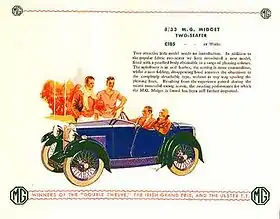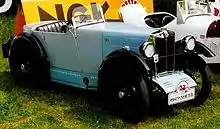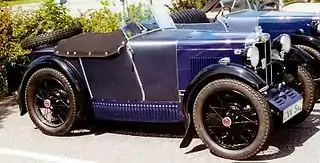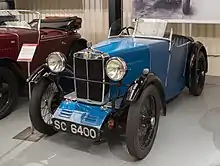MG M-type
The MG M-type (also known as the MG Midget) is a sports car that was produced by the MG Cars from April 1929 to 1932. It was sometimes referred to as the 8/33. Launched at the 1928 London Motor Show when the sales of the larger MG saloons was faltering because of the economic climate, the small car brought MG ownership to a new sector of the market and probably saved the company.[1] Early cars were made in the Cowley factory, but from 1930 production had transferred to Abingdon.
| MG M-type Midget | |
|---|---|
 | |
| Overview | |
| Manufacturer | MG |
| Production | 1929–1932 |
| Body and chassis | |
| Class | Sports car |
| Body style | 2-door Roadster Coupe |
| Chronology | |
| Predecessor | none |
| Successor | MG J-type |
Sports car
The M-Type was one of the first genuinely affordable sports cars to be offered by an established manufacturer, as opposed to modified versions of factory-built saloon cars and tourers.[2] By offering a car with excellent road manners and an entertaining driving experience at a low price (the new MG cost less than double the cheapest version of the Morris Minor on which it was based) despite relatively low overall performance the M-type set the template for many of the MG products that were to follow, as well as many of the other famous British sports cars of the 20th century. The M-type was also the first MG to wear the Midget name that would be used on a succession of small sports cars until 1980.
This 2-door sports car used an updated version of the four-cylinder bevel-gear driven overhead camshaft engine used in the 1928 Morris Minor and Wolseley 10 with a single SU carburettor giving 20 bhp (15 kW) at 4000 rpm. Drive was to the rear wheels through a three-speed non-synchromesh gearbox. The chassis was based on the one used in the 1928 Morris Minor with lowered suspension[2] using half-elliptic springs and Hartford friction disk shock absorbers with rigid front and rear axles and bolt on wire wheels. The car had a wheelbase of 78 inches (1980 mm) and a track of 42 inches (1067 mm).
1930 brought a series of improvements to the car. The Morris rod brake system, with the handbrake working on the transmission, was replaced a cable system with cross shaft coupled to the handbrake and the transmission brake deleted. Engine output was increased to 27 bhp (20 kW) by improving the camshaft and a four-speed gearbox was offered as an option. The doors became front-hinged. A supercharged version could be ordered from 1932, raising the top speed to 80 mph (130 km/h).
Early bodies were fabric-covered using a wood frame; this changed to all-metal in 1931. Most cars had bodies made by Carbodies of Coventry and fitted by MG in either open two-seat or closed two-door "Sportsmans" coupé versions, but some chassis were supplied to external coachbuilders such as Jarvis. The factory even made a van version as a service vehicle.
The car could reach 65 mph (105 km/h) and return 40 miles per gallon.[2] The open version cost £175 at launch,[1] soon rising to £185, and the coupé cost £245. The 1932 supercharged car cost £250.
The M-type had considerable sporting success, both privately and with official teams winning gold medals in the 1929 Land's End Trial[1] and class wins in the 1930 "Double Twelve" race at Brooklands. An entry was also made in the 1930 Le Mans 24 hour, but neither of the cars finished.
Gallery
 M.G. M-type Midget 2-Seater Sports 1929
M.G. M-type Midget 2-Seater Sports 1929 M.G. M-type Midget 2-Seater Sports 1929
M.G. M-type Midget 2-Seater Sports 1929 M.G. M-type Midget 2-Seater Sports 1930
M.G. M-type Midget 2-Seater Sports 1930 M.G. M-type Midget 2-Seater Sports 1930
M.G. M-type Midget 2-Seater Sports 1930 M.G. M-type Midget 2-Seater Sports 1930
M.G. M-type Midget 2-Seater Sports 1930 M.G. M-type 1930
M.G. M-type 1930 M.G. M-type Midget 2-Seater Sports 1931
M.G. M-type Midget 2-Seater Sports 1931 M.G. M-type 1930
M.G. M-type 1930
References
- Holmes, Mark (2007). Ultimate Convertibles: Roofless Beauty. London: Kandour. pp. 100–101. ISBN 978-1-905741-62-5.